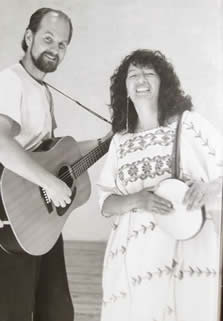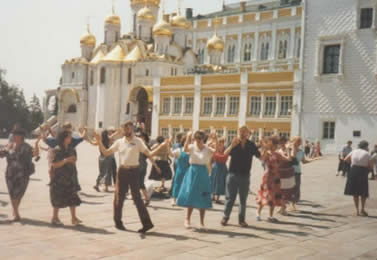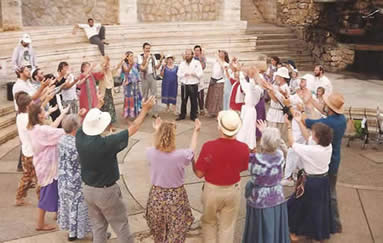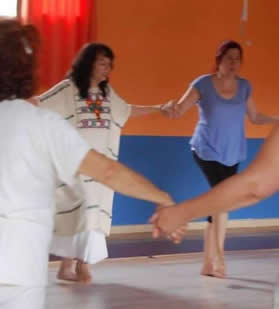History
of Dances of Universal Peace International
and the Guidance Council
Dances of Universal Peace International has undergone several transformations over more than three decades. Its first incarnation was co-founded in 1982 by Saadi Neil Douglas-Klotz and Tasnim Hermila Fernandez, two teachers from the Sufi Islamia Ruhaniat Society and the Sufi Order in the West respectively. As it was then called, the Center for the Study of Spiritual Dance and Walk was set up as a project of Khankah S.A.M., the Sufi community in San Francisco, CA centered around the former home of Murshid Samuel L. Lewis. The Center provided an on-site, live-in training program for those who wanted to study the Dances and Walks intensively in month-long modules.
Saadi and Tasnim in the early years of the Dance Center |
Within a year, the project had broadened considerably and become the Center for the Dances of Universal Peace, subtitled ‘a network and resource center.’ Based in Fairfax, California, the Center sought to connect Dancers and Dance circles around the world and provide training resources to them through printed materials and in-person retreats in various regions. During this phase and until 1988, the Center was a project of the Sufi Islamia Ruhaniat Society (SIRS), with the blessing and encouragement of the spiritual director and Pir of the Ruhaniat, Moineddin Jablonski the, spiritual successor of Murshid Samuel Lewis. The Center published a number of Dance notation booklets with recordings and kept a database of Dance teachers and regular circles (on a primitive—by today’s standards—computer). It also produced a quarterly newsletter and published a much-expanded update of the book Spiritual Dance and Walk: An Introduction.
During this period, the Center sponsored the first camps solely dedicated to the Dances and Walks, and training in them. The first such camp was held at Lama Foundation in New Mexico in August 1984 with Tasnim and Saadi as the main teachers. Key people who volunteered their help for the Center in this phase were: Ardvisura Carol Griffin, Malika Merrill and Kamae A Miller. An early board of advisors (which later became the first board of trustees) was set up which included: Mansur Rodney Kreps, Victoria Darvesha MacDonald, Salt Swan, Ellen Fietz Hall, Ardvisura, Malika, Kamae, Tasnim and Saadi.
In 1988, the Center sought its own non-profit, tax exempt status as an arts and service organization, adding PeaceWorks to its name. The idea was to access greater avenues of funding for helping the Dances spread beyond the Sufi community in which they had been birthed. However, the Center always maintained a close relationship with the SIRS. As Pir Moineddin wrote to the Ruhaniat Board of Trustees at the time:
“The organizational and legal bifurcation of SIRS and PeaceWorks a few years ago in no way affects the integrity of Murshid’s work as a whole. Murshid himself would have taken the same steps and incorporated the Dance work separately as an educational non-profit organization, just as Saadi did, so that restrictions as to grant aid and other practical considerations would not be as stringent as they are with SIRS, which is a religious non-profit organization” (letter, November 28, 1989).
Dancing in the Kremlin, 1989. |
During this period, largely through volunteer effort and self-funding by the key teachers, the Dance work quickly began to expand internationally. The Dance Center sponsored a citizen diplomacy trip to Russia in 1989, which led to ongoing support for circles there and an annual training for leaders held in England. In 1990, the Center began the annual “Peace through Arts” camp in England as an international gathering place for Dance teachers and dancers. (It was much easier for both Russians and Europeans to obtain visas to the UK, and travel costs were less.) The Center also sponsored a Dance peace pilgrimage to the Middle East (Israel, Jordan and Syria) in September 1993, which through shear synchronicity (or grace) coincided with the signing of the Oslo Accords. During both the Russian and Middle Eastern trips, a disciplined group of Dancers would appear in public places and invite others to join them in
dancing for and in peace. Some members would hand out cards in multiple languages explaining to onlookers what was happening. “Peace demonstration dancing” became a feature of this more activist phase of the Dances of Universal Peace work and was repeated in various forms in Atlanta, GA for the Olympics in 1996 as well as in public spaces in Canada, Australia and other places.
As part of the internationalization of the Dances, regional Dance networks were established in a number of countries, along with family or community camps that centered around the Dances and Walks. The first, and longest running, of such annual family Dance camps was established by the German Dance Network (NdL) in 1994, which today includes upwards of 300 adults and young people.
Dancing on Rosh Hashana in Jerusalem, 1993. |
Throughout the 1980s and 1990s, annual training events continued at the Lama Foundation, as well as in England, Germany, the Netherlands, Switzerland, Russia, Australia, Brasil and other countries. Key people who conducted or assisted in these early trainings, along with Tasnim and Saadi, were: Kamae Miller, Amida Harvey, Tansen Philip O’Donohoe, Gita Sophia Onnen, Rahmana Dziubany, Verena Karima Hochheimer, Alima Stoeckel, Michael Stoeckel, Barbara Kung, Zamyat Kirby, Anahata Moore, Matin Mize, Radha Tereska Buko, Noor and Akbar Helweg, Christina Schölziger, Zubeida Mitten-Lewis and Zahira Madeleine Bullock.
Under a model designed by Tasnim and Saadi, these trainings included various components still used today: concentration, visualization, meditation, sound and musicianship, voice, rhythm, walking meditation and body awareness. Spiritual practices from the (primarily) Sufi as well as Buddhist and Hindu traditions were interlaced with practical training in technique. For the first time, the trainings included the use of small ‘practice’ circles in which both beginning and intermediate dance leaders could receive feedback in a supportive atmosphere. A key feature of the original training model included the history of the Dances of Universal Peace “ancestors”—Murshid Samuel Lewis, Hazrat Inayat Khan and Ruth St. Denis. Some experience in Ruth St Denis’ creative meditations for ‘picking dances from the cosmos’ was also included. As part of the process of acknowledging the ancestors, in 1986 the SIRS published the book Sufi Vision and Initiation, the collected autobiographical writings of Murshid Samuel Lewis, edited by Neil Douglas-Klotz. To acknowledge and support the understanding of Ruth St. Denis’ role in Murshid S.A.M.’s inspiration for the Dances and Walks, in 1997 PeaceWorks published the book Wisdom Comes Dancing: Selected Writings of Ruth St. Denis on Dance, Spirituality and the Body, edited by Kamae A Miller.
Tasnim Fernandez leading Dances at Lama Foundation. |
In 1992, Saadi and Tasnim wrote the first version of the Dance certification guidelines and charter for the Mentor Teachers Guild (MTG) with the intention of broadening training to include more senior leaders. With the collaboration of other new mentors, the MTG published its ethical guidelines in 1996. In 2003 PeaceWorks produced the first edition of its Foundation Dance and Walks Manual, edited by Radha Tereska Buko, with the intention of providing reliable notation of the original Dances of Murshid Samuel Lewis as well as other foundational mantric Dances, which could be then translated into other languages in countries and regions where the Dances had taken root.
Through the first decade of the 21st century, the international focus for the Dances continued to expand, particularly moving into other countries in South America as well as Central and Eastern Europe. Two organization changes were undertaken. In the the early 2000s the North American DUP region was incorporated separately from Peaceworks under a plan developed by Ellen Fietz-Hall and others. A thorough organization review by the Unity Council in 2007-09 resulted in recommendations for reorganizing the international Dance organization which were adopted in August, 2009.
This necessitated other organizational name changes, including the International Network for the Dances of Universal Peace to the present Dances of Universal Peace International. The functions of the Mentor Teachers Guild were assumed by a new Guidance Council, and DUP International's focus shifted to supporting its work and providing services and resources to the "Leaders Guild", the name chosen for the worldwide body of mentored leaders of the Dances. The board of directors also became an international body, while at the same time the organization divested itself of responsibility for local matters while still providing resources and networking internationally through the greatly expanded capacity of the internet. During this period a number of individuals contributed significantly to reshaping the organization and updating the Guidelines for Leaders and Mentors, including Victoria Darversha, Halima Sussman, Malika Merrill, Murad Phil Notermann, Kabir Stuart McKinnon, Shabda Kahn, Wali Ali Meyer and Munir Peter Reynolds.
In 2022 we celebrated 40 years since the dance organization described above was set up. You can watch the event here.
Throughout all of the external change over the decades, the essential purpose of the group has remained: to allow more people to experience, and share further, the blessings of this deep and potentially transformative spiritual practice left to us by Murshid Samuel L. Lewis. Moving beyond philosophy to experience, the Dances remain one of the earliest and most potent expressions of the interspiritual impulse in the world, motivated by the human soul’s increasing compassion for all beings.
 English
English Español
Español Français
Français Deutsch
Deutsch Nederlands
Nederlands Português
Português Русский
Русский




